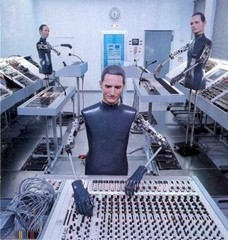 The nexus between technology and music is obviously a topic of great interest ’round Microkhan headquarters, so we couldn’t have been any more delighted to receive a gratis copy of Dave Tompkins’ How to Wreck a Nice Beach: The Vocoder from World War II to Hip-Hop a few weeks back. The book is everything a great piece of information art should be—killer dusty-corners research combined with insight and passion. But more than that, each page exudes Tompkins’ genuine wonderment and joy; whenever he pops off with a fresh anecdote about, say, Scottish intelligence agents or the Jonzun Crew, his excitement is palpable.
The nexus between technology and music is obviously a topic of great interest ’round Microkhan headquarters, so we couldn’t have been any more delighted to receive a gratis copy of Dave Tompkins’ How to Wreck a Nice Beach: The Vocoder from World War II to Hip-Hop a few weeks back. The book is everything a great piece of information art should be—killer dusty-corners research combined with insight and passion. But more than that, each page exudes Tompkins’ genuine wonderment and joy; whenever he pops off with a fresh anecdote about, say, Scottish intelligence agents or the Jonzun Crew, his excitement is palpable.
Needless to say, we learned a ton about how a Bell Labs’ creation changed the face of pop music forever, once the likes of Kraftwerk and Juan Atkins got their hands on vocoders. But let us just offer this tasty snippet regarding SIGSALY, the vocoder-based encryption system that protected Allied communications during World War II. The key to SIGSALY was the use of background noise (SIGGRUV), which was provided by an endless array of vinyl albums that were played once each, then discarded. Those albums, it turns out, were created by none other than the folks responsible for assaulting your ears with air pudding:
For the recording of SIGGRUV, the Signal Corps hired the Muzak Corporation, located at 46th Street in Times Square. Randomized covert noise was a considerable leap for a company that transmitted crooners and waltzes over phones lines. Intended for depressed office geraniums, Muzak was invented by George Owen Squier, a Signal Corps officer who spent World War I designing remote-control mine detonators. The company’s deceptive lull of a motto—”Muzak fills the deadly silences”—in a sense abided by SIGSALY’s strict policy of constant noise, though instead of Guy Lombardo, it was a concentration of millions of panicked electrons banging around inside fourteen-inch glass vacuum tubes…
More than 1,500 gold-splattered records were initially pressed and duplicated for synchronization on both ends of the conversation. Each record was one-sided as a safeguard against B-side confusion and assigned CB-trucker code names like Red Strawberry, Wild Dog and Circus Clown. As the war spread, the Pentagon began pressing up cheaper acetates in-house rather than risk shuttling throughout Manhattan by limousine. Upon completion, the records were transported via armored truck to a former girls’ school in Arlington, Virginia, and kept in a safe with the combination entrusted to three officers who were then blindfolded and turned around twenty-five times, thrown in the back of a white van, driven to the next county and dropped off in their underwear with a bag of peanuts and some kite string.
In addition to helping us defeat the Axis, the vocoder also contributed mightily to the sonic destruction of Miami.
More on How to Wreck a Nice Beach here. We sincerely hope that Italodisco pioneer Giorgio Moroder soon regrets his failure to return Tompkins’ e-mails.


Captured Shadow // Apr 6, 2010 at 4:19 pm
“who were then blindfolded and turned around twenty-five times, thrown in the back of a white van, driven to the next county and dropped off in their underwear with a bag of peanuts and some kite string.”
Seriously?
This sounds like Skull and Bones secrecy, not an actual process.
Brendan I. Koerner // Apr 6, 2010 at 4:23 pm
@Captured Shadow: Indeed. Can’t vouch for the veracity of that particular factoid; wish the book had endnotes so I could know the source.
Jordan // Apr 6, 2010 at 9:41 pm
There’s a fictionalized account of the creation of those records in Neal Stephenson’s “Cryptonomicon”, if I remember correctly.
jackal // Apr 8, 2010 at 5:18 am
Alas, Stockhausen was too young to have been a soldier fighting in the Wehrmacht — would make for quite a story if the pre-eminent originator of electronic-music (http://en.wikipedia.org/wiki/Karlheinz_Stockhausen) was inspired by his time listening in on allied vocoder-encoded signals.
… to be fair, this would be probably a rather inappropriate story, even for a Stephenson novel, since his mom was actually killed by the nazis..